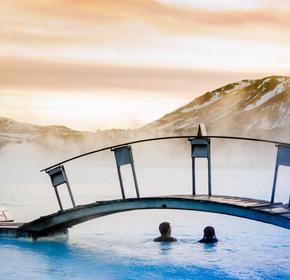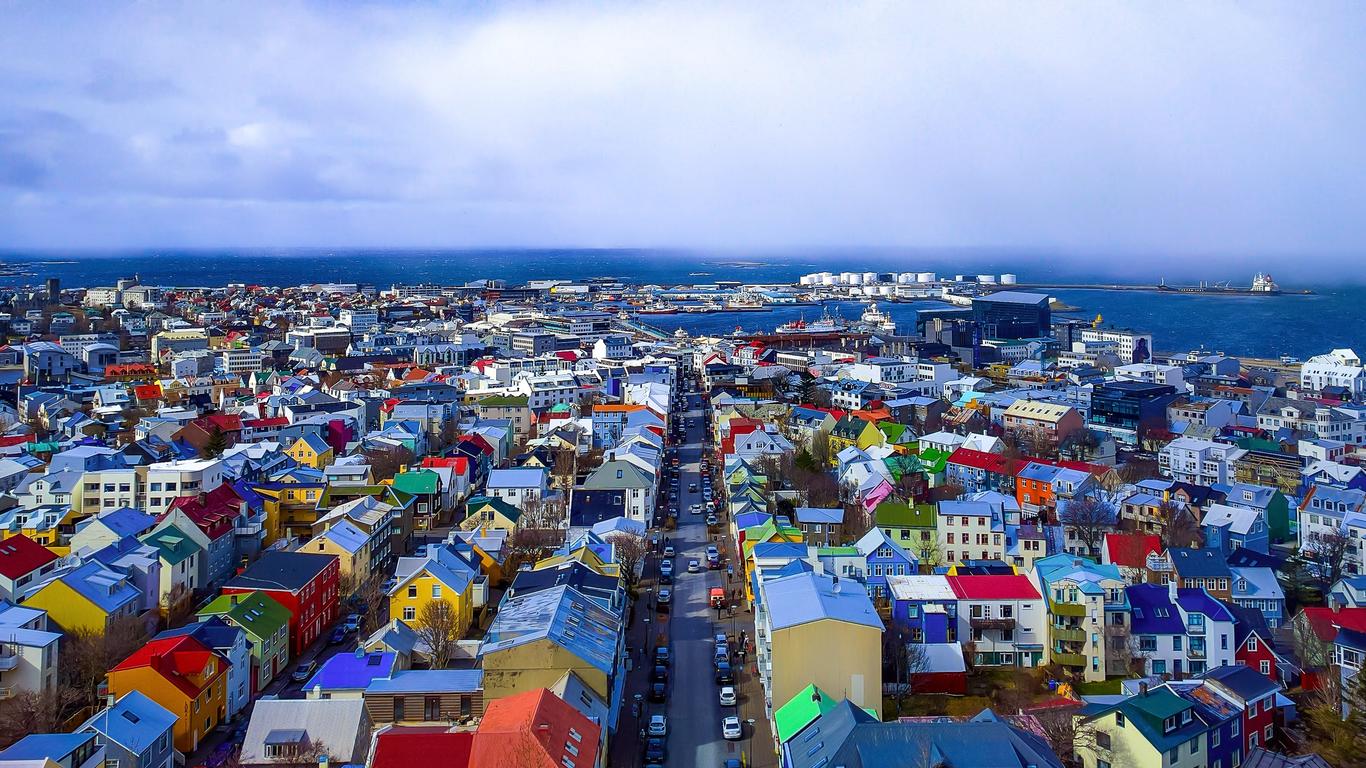
Reykjavik travel guide
Reykjavik Tourism | Reykjavik Guide
You're Going to Love Reykjavik
Iceland's capital may be a city of 120,000 people, but it's as busy and dynamic as places 10 times its size. This friendly, creative, and beautiful city punches well above its weight, and always leaves tourists wanting more.
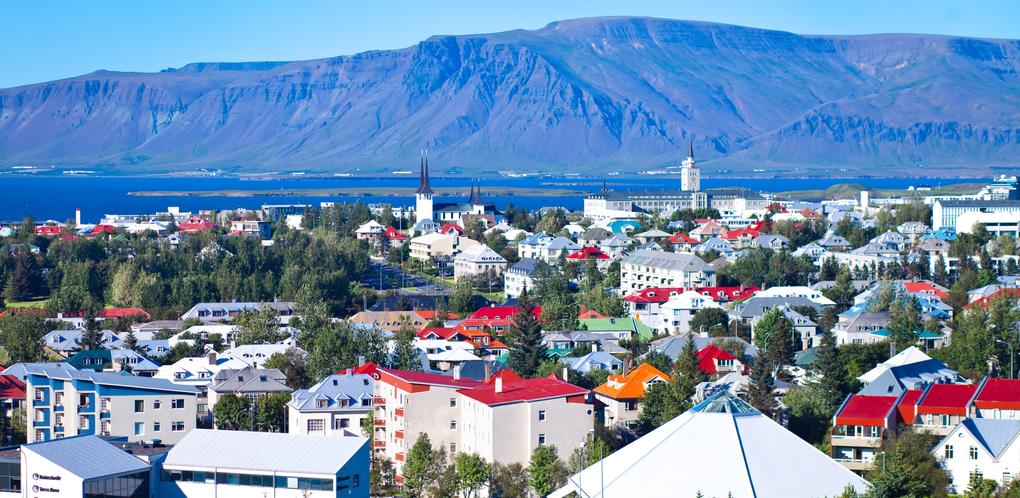
On one level, Reykjavik is made to walk around. Architectural highlights like the City Hall and the Hallgrímskirkja are a few minutes from bustling shopping streets like Laugavegur and cultural attractions like the National Museum of Iceland.
At another level, Reykjavik is a feast for the senses. Treat your taste buds to gourmet beef and fresh seafood at incredible restaurants. Gaze on the northern lights or spend an afternoon recharging your batteries in geothermal pools.
It may be compact, underrated, and hiding on a mid-Atlantic island, but Reykjavik is a fantastic place to visit and it's all within a couple of hours of America's Eastern Seaboard.
Top 5 Reasons to Visit Reykjavik
1. Relax in Geothermal Pools of the Blue Lagoon
The Blue Lagoon is one of Iceland's great tourist attractions and it's right on Reykjavik's doorstep. The mineral-rich, heated waters are a wonderful place to relax and luxuriate, even when the temperature approaches freezing.
2. Fantastic Food all over Town
Iceland is in the vanguard of the New Nordic Cuisine, and it's a fabulous gourmet destination. From fish specialists like Fiskfelagid to upmarket meat grills like Grillmarkadurinn, food lovers will be in their element.
3. The Beauty of Iceland's Glaciers
Reykjavik is also wonderfully situated as a base for excursions into Iceland's vast glaciers. Hook up with companies like Glacier Guides who will whisk you up to sites like Sólheimajökull where you can try ice climbing, ride snowmobiles, and see beautiful waterfalls.
4. See the Magnificent Northern Lights
The northern lights are a natural light show that can only be seen at northern latitudes and leave many people stunned by their beauty. In the winter and early spring, Iceland is the ideal place to see them in all their glory.
5. Stunning Modern Architecture
Iceland's capital is relatively young, so its architecture tends to be forward-thinking and modern. You can see that in the incredible Hallgrímskirkja (built in 1986), the cleverly adapted water tanks of the Perlan restaurant and City Hall (Ráðhúsið), which seems to float on a neighboring lake.
What to do in Reykjavik
1. Blue Lagoon: Caribbean on Ice
Known for its spectacular landscape filled with unexpected geological wonders, Iceland beckons visitors to this remarkable geothermal spa. The natural temperature of these mystical waters lingers between 98 and 102 degrees Fahrenheit, which is no surprise since it sits on a volcanic field. Tours reveal the history of the area, and the LAVA restaurant and bar celebrate the unique circumstances. A trip to the country is incomplete without a soak in these healing waters.
2. Hallgrímskirkja: Hymns of the Passion
This church of dwarfing proportions sits atop a hill near the waters of Reykjavik, and it beckons to tourists from far and wide. The modern architecture is nearly futuristic, and the building has become one of the most photographed attractions in the country. Also one of the tallest structures in Iceland, the incredible spire serves as an observation tower. Climb to the top for bayside views in one direction, and quaint colorful houses in the other.
3. Gullfoss: Everflowing Falls
The powerful Gullfoss waterfall is one of the most jaw-dropping natural spectacles in Iceland. Rainbows like you've never seen before traverse the skies over the Hvita River canyon on sunny days, while the booming white noise of gushing gallons of water instills marvelous serenity in every visitor. It is a must-see attraction year-round, as even in the cold months enchanting sheets of snow and ice dot the ever-rushing canyon.
4. Harpa: Harmony of Sight and Sound
Contemporary Scandinavian architecture has made its mark in recent years, and this is Iceland's own gem of design. The Harpa concert hall sits on the harbor, modernistically towering above traditional houses. The shimmering glass prisms that make up the facade blend together to reflect the unique basalt landscape for which so many travel to this isolated land. The Iceland Symphony Orchestra and the Icelandic Opera are worth catching on the inside.
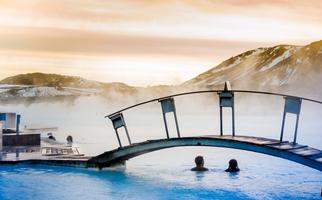
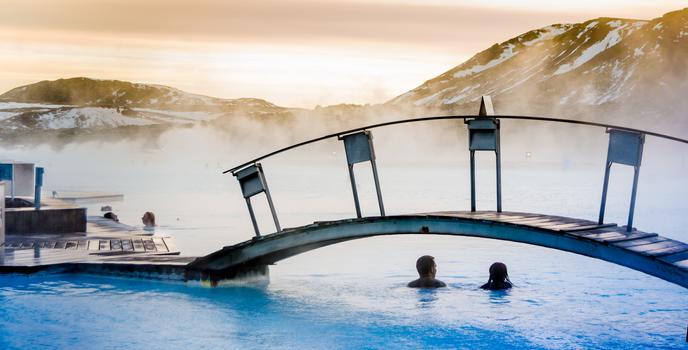
1. Blue Lagoon: Caribbean on Ice
Known for its spectacular landscape filled with unexpected geological wonders, Iceland beckons visitors to this remarkable geothermal spa. The natural temperature of these mystical waters lingers between 98 and 102 degrees Fahrenheit, which is no surprise since it sits on a volcanic field. Tours reveal the history of the area, and the LAVA restaurant and bar celebrate the unique circumstances. A trip to the country is incomplete without a soak in these healing waters.
2. Hallgrímskirkja: Hymns of the Passion
This church of dwarfing proportions sits atop a hill near the waters of Reykjavik, and it beckons to tourists from far and wide. The modern architecture is nearly futuristic, and the building has become one of the most photographed attractions in the country. Also one of the tallest structures in Iceland, the incredible spire serves as an observation tower. Climb to the top for bayside views in one direction, and quaint colorful houses in the other.
3. Gullfoss: Everflowing Falls
The powerful Gullfoss waterfall is one of the most jaw-dropping natural spectacles in Iceland. Rainbows like you've never seen before traverse the skies over the Hvita River canyon on sunny days, while the booming white noise of gushing gallons of water instills marvelous serenity in every visitor. It is a must-see attraction year-round, as even in the cold months enchanting sheets of snow and ice dot the ever-rushing canyon.
4. Harpa: Harmony of Sight and Sound
Contemporary Scandinavian architecture has made its mark in recent years, and this is Iceland's own gem of design. The Harpa concert hall sits on the harbor, modernistically towering above traditional houses. The shimmering glass prisms that make up the facade blend together to reflect the unique basalt landscape for which so many travel to this isolated land. The Iceland Symphony Orchestra and the Icelandic Opera are worth catching on the inside.


Where to Eat in Reykjavik
Iceland is at the forefront of what has been christened the "New Nordic Cuisine" and it's heaven for foodies. Ace chef Gunnar Karl Gíslason cooks up typical New Nordic delights at Dill. Don't miss the plokkfiskur (fish stew). Grillmarkadurinn is the place to go for grilled meats, while Fiskfelagid shows off Iceland's incredible seafood. From Arctic Char to Salt Cod, their fish dishes are sublime. Dining out isn't cheap in Reykjavik, at around kr10,000 for three courses, but it's definitely worth it.
When to visit Reykjavik
If you want to see the northern lights, head to Reykjavik between September and March and hope for some clear nights. For general sightseeing, July and August are ideal, with warm weather almost guaranteed. Many attractions shut down in the winter too, making summer probably the right time to visit.
How to Get to Reykjavik
Plane
Keflavík International Airport (KEF) has direct connections to plenty of American airports, from New York JFK to Minneapolis, Boston, and Denver. When you touch down, you can either take the Flybus (45 minutes, kr2,200) the Gray Line Airport Express (also 45 minutes, kr2,100), or the number 55 bus (45 minutes, kr1,680). Expect a taxi to cost between kr15,000 and kr20,000 depending on how many people need to be transported.
Car
Another option is to pick up a car rental from Keflavik, where you'll find branches of Hasso, Orange, and KEFCAR. If you are driving from the airport, it's about 35 miles from Keflavik to Reykjavik and the journey should take around 40 minutes. When you get out of the airport, look for Route 41, which runs directly into the capital.
Bus
There are bus services into Reykjavik from other parts of Iceland (but only West Iceland, South Iceland, and Akureyri have reliable bus connections, provided by Sterna Travel). Bus tours are an excellent way to see the northern lights, the blue lagoon, and the south coast.
Airlines serving Reykjavik
Where to stay in Reykjavik
101 Reykjavik - 101 Reykjavik is the center of town (the 101 is the area's postal code) and the home to Iceland's political and cultural elites. It's also where the most upscale hotels are, along with most of the city's best bars and restaurants.
Popular Neighborhoods in Reykjavik
Vesturbær - literally the "West Town", Vesturbær is tucked away from the nightlife and is a more peaceful, modest part of the city. However, even though it's quiet, Vesturbær is just 20 minutes walk from the city center, so it's superbly situated.
Austurborg - the eastern part of the city is much like the west, but with a little more energy. It's also where you'll find the spectacular Hallgrímskirkja, Reykjavik's modern cathedral, as well as Klambratún, the city's largest park.
Where to stay in popular areas of Reykjavik
Most booked hotels in Reykjavik
How to Get Around Reykjavik
Public Transportation
Although Reykjavik is easily walkable, the Strætó bus network provides excellent coverage, so you'll probably find yourself using it at least once. A single journey costs kr420, and exact change is recommended (as you won't get any back). A Reykjavík City Card is a more economical option, providing cut price travel and access to major attractions. It costs kr3,500 for a single day and kr5,500 for three days. If you head out partying in central Reykjavik, be aware that the buses shut down at around 11 pm, so you may need to arrange a taxi if you need to get home late at night.
Taxi
Taxis are reliable, safe, and comfortable in Reykjavik, but they aren't cheap. The meter drop is fixed at kr660, and then there's a charge of around kr1,000 per mile.
Car
Renting a car at Keflavik or downtown locations is a good option, particularly in the summer months when all of the regional roads are passable and you can see the whole island. Parking is easy to come by in the Kolaportið area and around the harbor, and meter payments vary depending on which of the four parking zones you are in. Rates vary from kr90 per hour to kr250, so it makes sense to find a spot in Zone 3 (the cheapest) if you can. Parking on Sundays is always free, as is parking after 6 pm on weekdays. Rental costs can be relatively expensive, but you can find vehicles for as little as kr2,400 per day.
Best car hire deals in Reykjavik
Economy
2 Adults, 2 Bags
AED 129/day
Economy
2 Adults, 2 Bags
AED 153/day
The Cost of Living in Reykjavik
Shopping Streets
Reykjavik has a dynamic fashion and crafts scene, and its epicenter is Laugavegur in the center of town. This is the place to visit if you want to check out fashion boutiques like Kiosk, vintage stores like Spúútnik, and homeware boutiques like Hrím. The flea market at Kolaportið is also not to be missed, offering vintage outfits, vinyl records, books, jewelry, and a vast selection of souvenirs for tourists to take home.
Groceries and Other
Shopping for food and drink in Reykjavik can be expensive, but visiting local supermarkets like Bónus, Krónan, and Nettó will make it more manageable. Still, expect a gallon of milk to cost around kr560 and 12 eggs to come to kr630.
